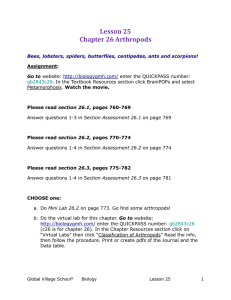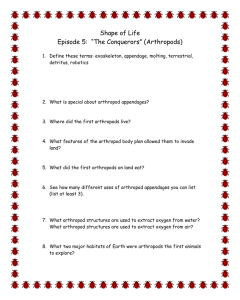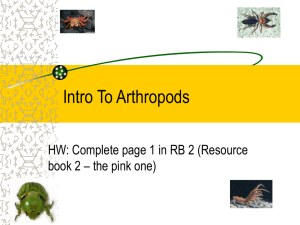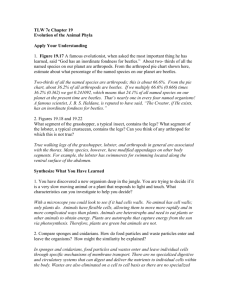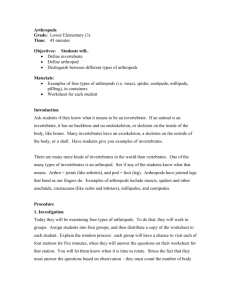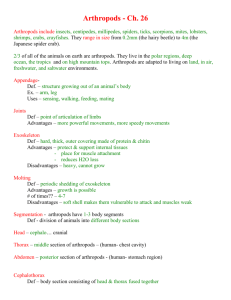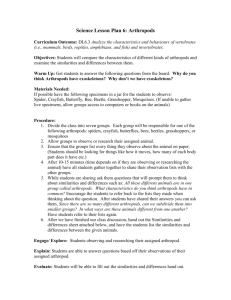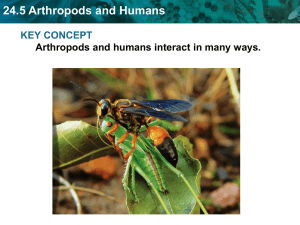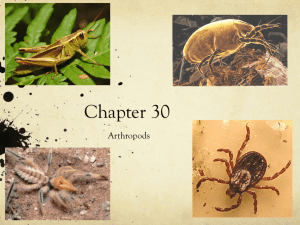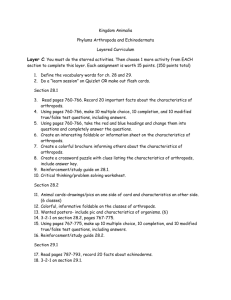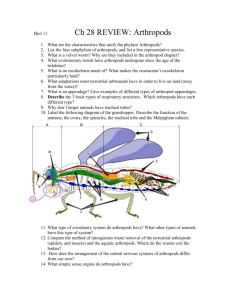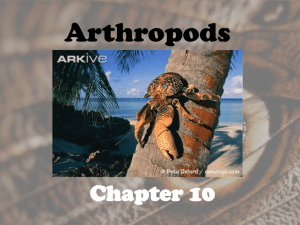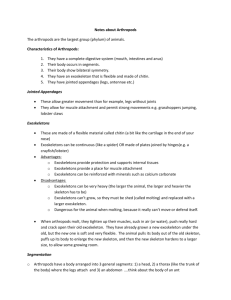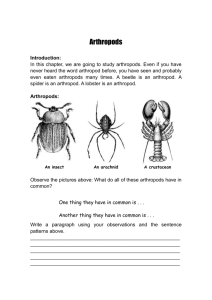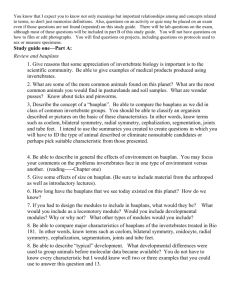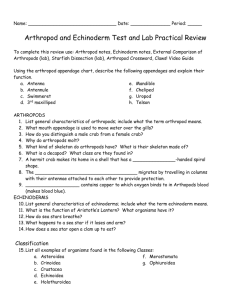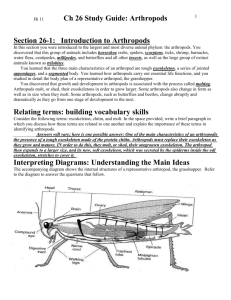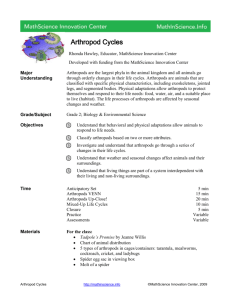Ch 28 Arthropods
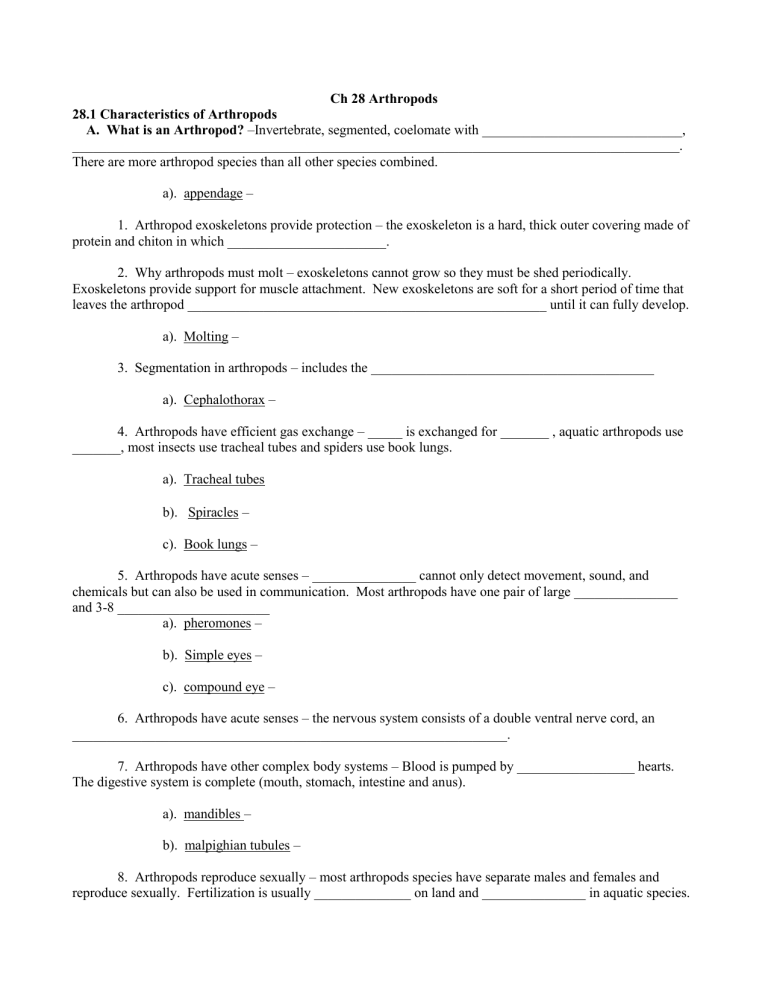
Ch 28 Arthropods
28.1 Characteristics of Arthropods
A. What is an Arthropod?
–Invertebrate, segmented, coelomate with _____________________________,
________________________________________________________________________________________.
There are more arthropod species than all other species combined. a). appendage –
1. Arthropod exoskeletons provide protection – the exoskeleton is a hard, thick outer covering made of protein and chiton in which _______________________.
2. Why arthropods must molt – exoskeletons cannot grow so they must be shed periodically.
Exoskeletons provide support for muscle attachment. New exoskeletons are soft for a short period of time that leaves the arthropod ____________________________________________________ until it can fully develop. a). Molting –
3. Segmentation in arthropods – includes the _________________________________________ a). Cephalothorax –
4. Arthropods have efficient gas exchange – _____ is exchanged for _______ , aquatic arthropods use
_______, most insects use tracheal tubes and spiders use book lungs. a). Tracheal tubes b). Spiracles – c). Book lungs –
5. Arthropods have acute senses – _______________ cannot only detect movement, sound, and chemicals but can also be used in communication. Most arthropods have one pair of large _______________ and 3-8 ______________________ a). pheromones – b). Simple eyes – c). compound eye –
6. Arthropods have acute senses – the nervous system consists of a double ventral nerve cord, an
_______________________________________________________________.
7. Arthropods have other complex body systems – Blood is pumped by _________________ hearts.
The digestive system is complete (mouth, stomach, intestine and anus). a). mandibles – b). malpighian tubules –
8. Arthropods reproduce sexually – most arthropods species have separate males and females and reproduce sexually. Fertilization is usually ______________ on land and _______________ in aquatic species.
a). parthenogenesis –
28.2 Diversity of Arthropods
A. Arachnids – ___________________________________ includes spiders, scorpions, mites and ticks
1. What is an arachnid? An arthropod w/ ________________ of jointed appendages and 2 body regions: _______________________________. They have __________ pairs of walking legs and no antennae. a). chelicerae – b). pedipalps – c). spinnerets –
2. Ticks, mites, and scorpions: Spider relatives – ticks and mites have __________ body segment.
Scorpions have enlarged pincers and a venomous tail used to paralyze prey.
C. Crustaceans – (ex: Crabs, lobsters, shrimps, crayfish, barnacles and pill bugs) most are aquatic w/ gills.
Only arthropods w/ ___________________. All have mandibles, 2 compound eyes________________ of walking legs (1 st pair are strong claws).
D. Centipedes and Millipedes – Centipedes are carnivorous and belong to the class ______________.
Millepedes eat plants and dead material and belong to the class _______________________
E. Horseshoe Crabs: Living Fossils – Members of the class _________________________.
F. Insects – by far, the largest class of arthropods
1. Insect reproduction – insects mate about once during their lifetime. The eggs are fertilized internally.
Most insects lay a large number of eggs. ____________________ of insects go through complete metamorphosis. This is advantages because it decreases the competition for food. Larva may eat leaves and adults nectar (ex: butterfly)
2. Metamorphosis: Change in body shape and form – some insects hatch into miniature adult versions
(ex: silverfish). Others go through a series of changes. a). metamorphosis – b). larva – c). pupa –
3. Incomplete metamorphosis has three stages – _________________________________________.
The nymph molts several times and eventually becomes and adult who can reproduce. (ex: grasshoppers, and cockroaches) a). nymph –
